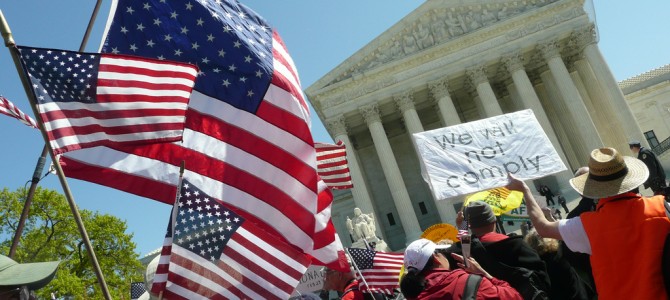
The Supreme Court granted cert last week in what promises to be another landmark case on religious liberty — call it the Masterpiece Cakeshop case of war memorials. In The American Legion et al. v. American Humanist Association et al, the Supreme Court will decide whether to reverse a lower court decision that ruled the Bladensburg World War I Veterans Memorial should be removed. The plaintiffs argue a public monument that includes any aspect of Christianity entangles government and religion and is therefore unconstitutional.
The Bladensburg World War I Veterans Memorial is a 93-year-old cross-shaped monument that sits in Prince George’s County, Maryland, on state land. Decades ago, local Gold Star mothers spearheaded the project to honor 49 Prince George’s County men who gave their lives while serving in WWI.
They chose a cross shape to mimic the cross-shaped grave markers standing over the countless American graves on the Western Front of that war. This gesture was particularly meaningful for family members who were unable to bury their dead on U.S. soil. The monument stood for dozens of years, until 2014, when the American Humanist Association filed a lawsuit claiming the cross-shaped memorial was unconstitutional.
In 2015, the U.S. District Court for the District of Maryland disagreed, ruling the memorial was in fact constitutional. Crosses mark the graves of fallen American servicemen overseas, in Arlington cemetery, and in hundreds of other important places we remember the fallen.
Later, the U.S. Court of Appeals for the Fourth Circuit reversed the district court’s decision. They claimed it violates the Establishment Clause of the First Amendment. In that decision, Judge Thacker, an Obama appointee, wrote, “Even with the nonreligious elements, the sectarian elements easily overwhelm the secular ones.” His peer, Chief Judge Gregory, disagreed, saying the language in the First Amendment doesn’t necessarily mean the government must “purge from the public sphere any reference to religion.”
The Supreme Court will now hear the merits of the case and decide if the latest ruling that found the monument unconstitutional should stand or not. As was to be expected, liberals are not happy the Supreme Court decided to hear this case. For starters, it’s typically a good sign when the court wants to hear something. It means they might disagree with the previous ruling. The Supreme Court has reversed 70 percent of lower court rulings since 2007, so the chances the previous decision will be overturned are high.
Second, and likely the larger complaint among liberals, is they loathe actions that seem to intertwine religion and the state. The problem with that is that they also believe in a large state, so many more things would come under the purview of this idea.
Already, the writers at Think Progress moaned, “The Supreme Court just agreed to hear a case that could nuke separation of church and state.” Before the case has even been represented, they whined, “Get ready for a whole lot more religious icons in government buildings.” This is an eye-roll-inducing observation if there ever was one — anyone know what words are emblazoned on U.S. currency printed by the U.S. government at the courtesy of U.S. taxpayers?
Still, progressives are correct that the Supreme Court’s decision to even hear the case reopens an old wound, although it’s unclear how a reversal would spur a movement to construct religious monuments in government buildings nationwide. In 2005, the Supreme Court heard a (somewhat) similar case, Van Orden v. Perry, which involved whether a display of the Ten Commandments at the state capitol in Austin, Texas violated the Establishment Clause. The Supreme Court ruled by a narrow margin of 5-4 that it was constitutional, partly due to the fact that they did not apply the so-called “Lemon Test” deeming the display a “passive monument.”
Undoubtedly liberals are scared that another decision reversing the lower court, by however narrow or wide a margin, would cement the country’s persistent desire to safeguard national monuments and its Christian religious heritage.
As often happens with cases the Supreme Court decides to address, this one is somewhat more complicated and multifaceted. Like Masterpiece, this case could stir up controversy for those passionate about the First Amendment, particularly the Establishment Clause. The justices will determine 1) whether the memorial is unconstitutional merely because it is shaped like a cross, 2) whether this case should be reviewed with Lemon v. Kurtzman (or, as religious freedom geeks call it, the “Lemon Test”) in mind, and 3) if the test applies, if the upkeep of the memorial entangles the government and religion in violation of the First Amendment.
What is the Lemon test? Established in 1971, it’s the judicial criteria typically used to see whether a law violates the Establishment Clause. Does the law have a secular purpose? Or does it look like the government is endorsing or excessively tangled in religion? The test has become a bone of contention among many conservatives, particularly religious freedom advocates, because they argue it does not represent the founders’ original intent in the Constitution. Supreme Court Justice Antonin Scalia once likened the Lemon test to that of a “ghoul in a late-night horror movie.”
Either way, whether the justices determine the Lemon test applies and if so, whether this memorial violates it, will have significant implications for existing monuments that have religious symbolism incorporated into them. Kelly Shackelford, president and CEO of the legal organization First Liberty, said in a statement: “If this monument is bulldozed to the ground, it’s only a matter of time before the wrecking ball turns on Arlington National Cemetery and the hundreds of memorials like this one across the country.”









